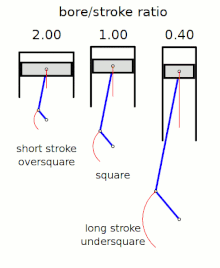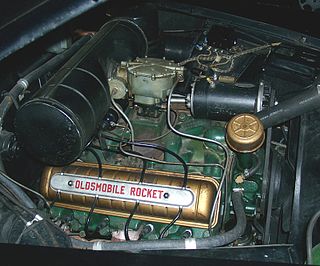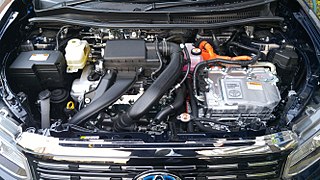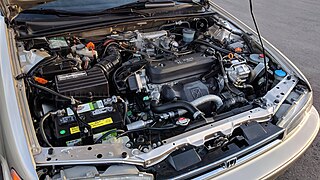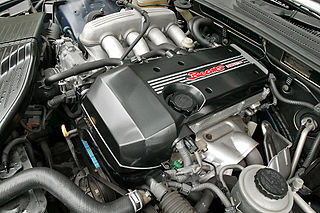At a given engine speed, a longer stroke increases engine friction and increases stress on the crankshaft due to the higher peak piston acceleration. The smaller bore also reduces the area available for valves in the cylinder head, requiring them to be smaller or fewer in number.
Undersquare engines often exhibit peak torque at lower rpm than an oversquare engine due to their smaller valves and high piston speed limiting their potential to rev higher.
Undersquare engine examples
Many inline engines, particularly those mounted transversely in front-wheel-drive cars, utilize an undersquare design. The smaller bore allows for a shorter engine that increases room available for the front wheels to steer. Examples of this include many Volkswagen, Nissan, Honda, and Mazda engines. The 1KR-FE-engine used in the Toyota Aygo, Citroën C1 and Peugeot 107 amongst others is an example of a modern long-stroke engine widely used in FF layout cars. This engine has a bore and stroke of 71 mm × 84 mm (2.8 in × 3.3 in) stroke giving it a bore/stroke ratio of 0.845:1. Some rear-wheel-drive cars that borrow engines from front-wheel-drive cars (such as the Mazda MX-5) use an undersquare design.
BMW's acclaimed S54B32 M54 engine was undersquare with a bore and stroke of 87 mm × 91 mm (3.4 in × 3.6 in)), offering a world record torque-per-litre figure (114 N⋅m/L, 1.38 lb⋅ft/cu in) for normally-aspirated production engines at the time; this record stood until Ferrari unveiled the 458 Italia.
Many British automobile companies used undersquare designs until the 1950s, largely because of a motor tax system that taxed cars by their cylinder bore. This includes the BMC A-Series engine, and many Nissan derivatives. The Trojan Car used an undersquare, split piston, two stroke, two-cylinder inline engine; this was partly for this tax advantage and partly because its proportions allowed flexing V-shaped connecting rods for the two pistons of each U-shaped cylinder, which was cheaper and simpler than two connecting rods joined with an additional bearing.
Their French and German competitors at the time also used undersquare designs even in absence of the tax reasoning, e. g. Renault Billancourt engine and Opel straight-6 engine.
The 225 cu in (3.7 litre) Chrysler Slant-6 engine is undersquare, with a bore and stroke of 86 mm × 105 mm (3.4 in × 4.1 in) stroke (bore/stroke ratio = 0.819:1).
The Ford 5.4L Modular Engine features a bore and stroke of 90.1 mm × 105.8 mm (3.55 in × 4.17 in), which makes a bore/stroke ratio of 0.852:1. Since the stroke is significantly longer than the bore, the SOHC 16V (2-valve per cylinder) version of this engine is able to generate a peak torque of 350 lb·ft as low as 2501 rpm.
The Willys Jeep L134 and F134 engines were undersquare, with a bore and stroke of 79.4 mm × 111.1 mm (3.13 in × 4.37 in) stroke (bore/stroke ratio = 0.714:1).
The Dodge Power Wagon used a straight-six Chrysler Flathead engine of 230 cu in (3.8 L) with a bore and stroke of 83 mm × 117 mm (3.3 in × 4.6 in), yielding a substantially undersquare bore/stroke ratio of 0.709:1.
The 4-litre Barra Inline 6 engine from the Australian Ford Falcon, uses a bore and stroke of 92.21 mm × 99.31 mm (3.63 in × 3.91 in) stroke, which equates to a 0.929:1 bore-stroke ratio.
The 292 Chevrolet I6 is also undersquare, with a bore and stroke of 98.4 mm × 104.8 mm (3.875 in × 4.125 in) in (bore/stroke ratio = 0.939:1).
Mitsubishi's 4G63T engine found primarily in many generations of Mitsubishi Lancer Evolution is an undersquare engine with a bore and stroke of 85 mm × 88 mm (3.3 in × 3.5 in).
The Jaguar XK6 engine, used in all 6-cylinder Jaguars from 1949 to 1987 was undersquare. For example, the 4.2 litre engine had a bore and stroke of 92.08 mm × 106 mm (3.63 in × 4.17 in), providing a bore/stroke ratio of 0.869:1.
Virtually all piston engines used in military aircraft were long-stroke engines. The PW R-2800, Wright R-3350, Pratt & Whitney R-4360 Wasp Major, Rolls-Royce Merlin (1650), Allison V-1710, and Hispano-Suiza 12Y-Z are only a few of more than a hundred examples.
All diesel-powered ships have massively undersquare marine engines, usually using crossheads. A Wärtsilä two-stroke marine diesel engine has a bore and stroke of 960 mm × 2,500 mm (37.8 in × 98.4 in), (bore/stroke ratio = 0.384:1).
While most modern motorcycle engines are square or oversquare, some are undersquare. The Kawasaki Z1300's straight-six engine was made undersquare to minimise engine width, more recently, a new straight-twin engine for the Honda NC700 series used an undersquare design to achieve better combustion efficiency in order to reduce fuel consumption. [10] [11]
